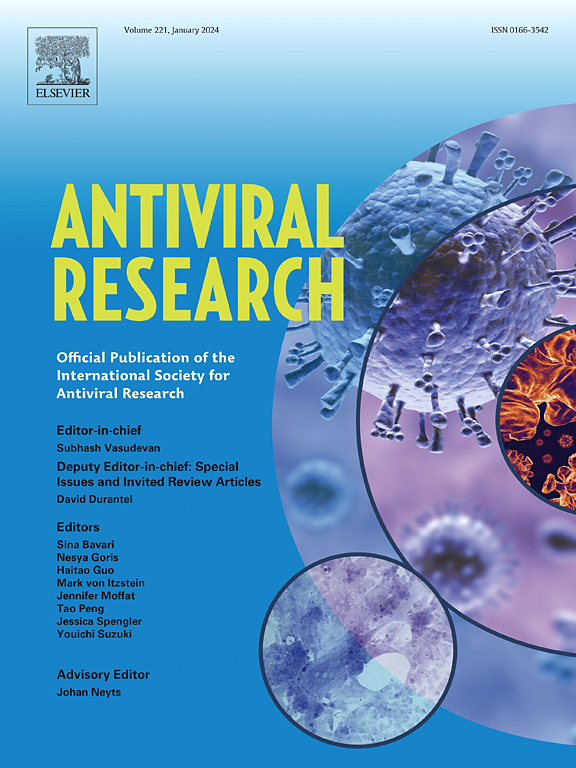Lysergol exerts potent antiviral activity against the emerging Oropouche virus in vitro
IF 4.5
2区 医学
Q1 PHARMACOLOGY & PHARMACY
引用次数: 0
Abstract
Oropouche virus (OROV) has caused a new outbreak, with thousands of cases of febrile disease in South and Central America, including regions where the virus was not detected before. Oropouche fever is a neglected mosquito-borne disease that still lacks options for antiviral treatment. We developed a high-throughput screening phenotypic assay using human hepatocyte-derived HuH-7.0 cells to screen over 7700 compounds against OROV infection. We identified 13 hit compounds that were protective against OROV-induced cytopathic effect in cell culture, of which 3 were confirmed: lysergol, amiloride hydrochloride, and pyridostatin TFA, with EC50 values below 2 μM. Orthogonal assays indicate that both lysergol and pyridostatin present antiviral activity against OROV in HuH-7.0 and T24 cell lines, but lysergol is far more potent, causing up to a 100,000-fold reduction in viral load in the low micromolar range. Mechanistic studies indicate that the antiviral effect of lysergol affects early stages of viral replication, and that lysergol is also active against a recently isolated OROV strain. In conclusion, our phenotypical screening campaign led to the identification of a first-in-class compound with potent antiviral activity against the emerging OROV in cell culture. We conclude that high-throughput screening assays can be implemented in response to the emergence of arboviruses and accelerate the discovery of candidate treatments.

麦芽糖醇在体外对新出现的Oropouche病毒具有有效的抗病毒活性
奥罗普切病毒(OROV)在南美洲和中美洲爆发了新一轮疫情,造成数千例发热病例,其中包括以前未发现该病毒的地区。奥罗普切热是一种被忽视的蚊媒疾病,目前仍缺乏抗病毒治疗方案。我们利用人体肝细胞衍生的 HuH-7.0 细胞开发了一种高通量筛选表型测定法,筛选出 7700 多种抗 OROV 感染的化合物。我们确定了 13 种对细胞培养中 OROV 诱导的细胞病理效应具有保护作用的命中化合物,其中 3 种得到证实:来苏儿醇、盐酸阿米洛利和哒嗪霉素 TFA,其 EC50 值低于 2 μM。正交试验表明,来苏尔和哒嗪类药物对 HuH-7.0 和 T24 细胞系中的 OROV 均具有抗病毒活性,但来苏尔的效力更强,在低微摩尔范围内可使病毒载量减少高达 100,000 倍。机理研究表明,麦角醇的抗病毒作用会影响病毒复制的早期阶段,而且麦角醇对最近分离出的 OROV 株也有活性。总之,通过表型筛选活动,我们发现了一种在细胞培养中对新出现的 OROV 具有强效抗病毒活性的一流化合物。我们的结论是,高通量筛选试验可用于应对虫媒病毒的出现,并加快候选治疗方法的发现。
本文章由计算机程序翻译,如有差异,请以英文原文为准。
求助全文
约1分钟内获得全文
求助全文
来源期刊

Antiviral research
医学-病毒学
CiteScore
17.10
自引率
3.90%
发文量
157
审稿时长
34 days
期刊介绍:
Antiviral Research is a journal that focuses on various aspects of controlling viral infections in both humans and animals. It is a platform for publishing research reports, short communications, review articles, and commentaries. The journal covers a wide range of topics including antiviral drugs, antibodies, and host-response modifiers. These topics encompass their synthesis, in vitro and in vivo testing, as well as mechanisms of action. Additionally, the journal also publishes studies on the development of new or improved vaccines against viral infections in humans. It delves into assessing the safety of drugs and vaccines, tracking the evolution of drug or vaccine-resistant viruses, and developing effective countermeasures. Another area of interest includes the identification and validation of new drug targets. The journal further explores laboratory animal models of viral diseases, investigates the pathogenesis of viral diseases, and examines the mechanisms by which viruses avoid host immune responses.
 求助内容:
求助内容: 应助结果提醒方式:
应助结果提醒方式:


